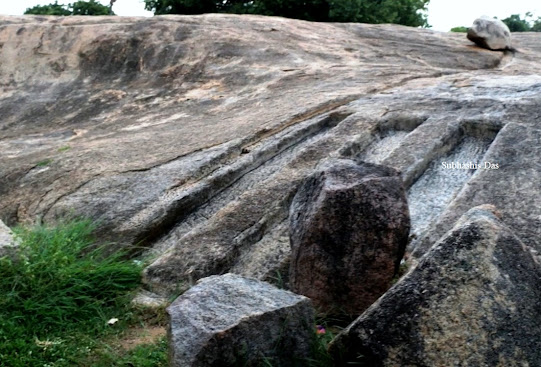Subhashis Das
Setagarha pahadi, perhaps the largest hill in Hazaribagh district is located about 12 kms SE of Hazaribagh town.
When I was a child and residing at Hazaribagh in Jharkhand the large hill in the neighbourhood of the town which is presently labelled as Sitagarh pahad was called Setagarha pahadi (a female hill; hence pahadi) and it still is amongst several old timers of the town and villages.
The Setagarha Pahadi
The Hill has received its name from a nearby village of the same name and is also known with varied names as Chandwar, Zulzul as per the villages in the vicinity.
The Setagarha Pahadi, in the British maps is labelled as Chandwar and a Britisher has painted and sketched this hill labelling it as Mount Gloomy for reasons best known to them. Was the hill called Mt. Gloomy by them during the 19th cent? I cannot say.

Setagarha pahadi sketched as Mount Gloomy by the British in 1813
The term Setagarha has stemmed from two austric words of "Seta" which in Santali means a "wild dog" and "garha" is suggestive of a "burial" (of the dog somewhere in or in the foot of the large hill sometime in antiquity). Meaning some dog, dear to a tribal in the deep past must have been buried here. Dogs were and still are the closest friends of the tribals. The custom of burying both dogs and horses after their death was a common custom among the tribals the world over.
The menhir in the very ancient Birbir megalithic site is aligned towards the "V" notch of the Setagarha Pahadi
The megalithic folks in antiquity revered the hill as their pregnant Recumbent Mother Goddess form (pertaining to the once prevalent fertility cult) and they aligned several of their ancient megalithic structures towards the notches and peaks of this hill. An example of such an orientation can be viewed in the image above
A large Buddhist monastery has been unearthed at the foot of the Setagarha pahadi near Burhanpur towards the South-Eastern side of the hill by Archaeological Survey of India revealing idols of Goddess Tara, Avaloketiswara and several Bhumi Sparsha Mudra idols of the Buddha etc.
The idols of the Bhumi-Sparsha mudra Buddha, Tara etc from the Buddhist temple/monastery excavated by ASI at Burhanpur at the foothill of Setagarha Pahadi
Excavated images of the Buddha in Bhumi Sparsha Mudra.
Excavated statue of the AVALOKITESVARA
One of the homes of Burhanpur possessed a votive stupa and a fragment of a dancing girl collected from the site prior to the excavation. Several other Buddhists idols that were housed in the homes of the villagers had their faces defaced hinting towards a foul play in the past. Scholars rummaging the hill in hope of archaeological relics are reported to have found coins belonging to the Shah Alam period.
This votive stupa was inside the home of a villager collected in-situ from the site prior to the excavationI saw this broken relic of a possible dancing girl in the same house which was collected from the site prior to the site's excavation
Archaeological Survey of India plans to set up a site museum near the excavated monastery.
A rock shelter can be viewed at the South-East facade of the hill albeit no rock painting has been reported from here.
A rock shelter at the South Eastern facade of the Setagarha Pahadi
The hill top is reported to house a well and a pond for ritualistic worship here. A sacred grove or the "mandar" of the village comprises a sacred stone that lies towards the South east of the hill (Image below).
A sacred stone inside a sacred grove lies towards the South East of the Setagraha pahadi




.JPG)

.jpg)





















.jpg)















.JPG)








